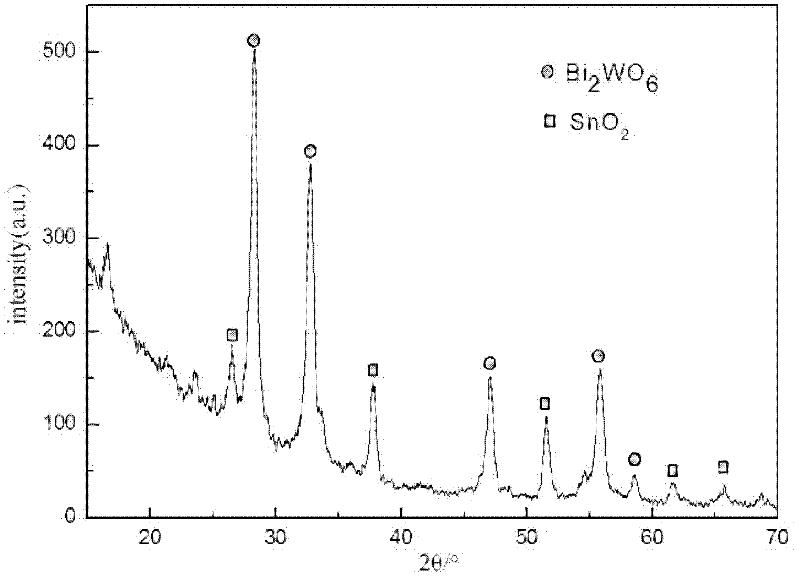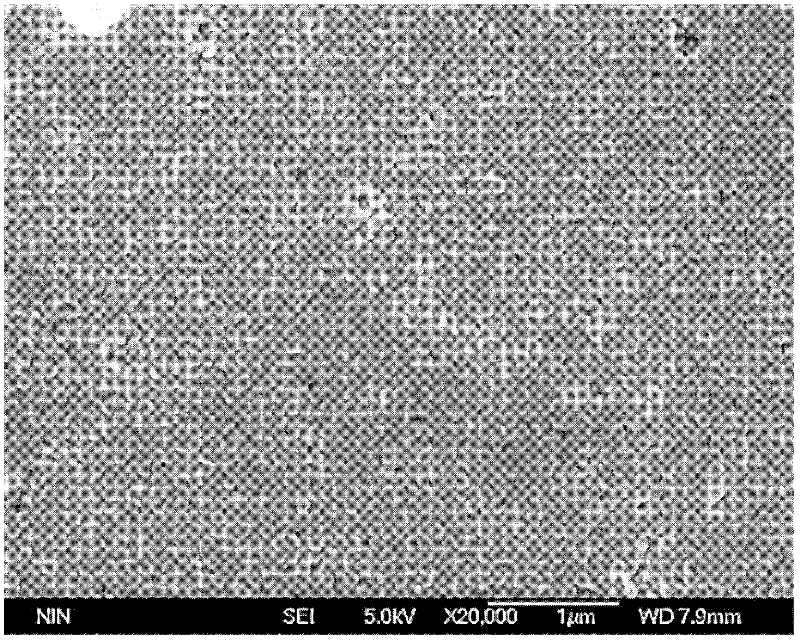Method for preparing bismuth tungstate film in sol-gel method
A sol-gel method, bismuth tungstate technology, applied in chemical instruments and methods, tungsten compounds, inorganic chemistry, etc., can solve the problems of low utilization rate of sunlight, large forbidden band width, etc., and meet the requirements of low experimental conditions, Simple operation and short preparation cycle
- Summary
- Abstract
- Description
- Claims
- Application Information
AI Technical Summary
Problems solved by technology
Method used
Image
Examples
Embodiment 1
[0031] Step 1: Select the FTO / glass substrate as the substrate, and place the cut FTO substrate in detergent, acetone, and ethanol for ultrasonic cleaning for 10 minutes each to remove impurities such as grease on the surface of the FTO / glass substrate; Finally, rinse the substrate with a large amount of distilled water, and finally dry it with nitrogen;
[0032] Step 2: Place the clean FTO substrate in an ultraviolet irradiator for 5-30 minutes to make the surface of the substrate reach "atomic cleanliness". The high energy of ultraviolet radiation can break the Sn-O bond in it, forming a hydroxyl group with better hydrophilicity, and improving the hydrophilicity of the substrate;
[0033] Step 3: Weigh Na at a molar ratio of 1:2.1 2 WO 4 2H 2 O and Bi(NO 3 ) 3 ·5H 2 O (due to the volatilization of Bi oxide during heating), the Na 2 WO 4 2H 2 O and an excess of 5% Bi(NO 3 ) 3 ·5H 2 O was dissolved in ethylene glycol respectively, and Bi(NO 3 ) 3 ·5H 2 O and Na ...
Embodiment 2
[0037] Step 1: Select the FTO / glass substrate as the substrate, and place the cut FTO substrate in detergent, acetone, and ethanol for ultrasonic cleaning for 10 minutes each to remove impurities such as grease on the surface of the FTO / glass substrate; Finally, rinse the substrate with a large amount of distilled water, and finally dry it with nitrogen;
[0038] Step 2: Place the clean FTO substrate in an ultraviolet irradiator for 5-30 minutes to make the surface of the substrate reach "atomic cleanliness". The high energy of ultraviolet radiation can break the Sn-O bond in it, forming a hydroxyl group with better hydrophilicity, and improving the hydrophilicity of the substrate;
[0039] Step 3: Weigh Na at a molar ratio of 1:2.1 2 WO 4 2H 2 O and Bi(NO 3 ) 3 ·5H 2 O (due to the volatilization of Bi oxide during heating), the Na 2 WO 4 2H 2 O and an excess of 5% Bi(NO 3 ) 3 ·5H 2 O was dissolved in ethylene glycol respectively, and Bi(NO 3 ) 3 ·5H 2 O and Na ...
Embodiment 3
[0043] Step 1: Select the FTO / glass substrate as the substrate, and place the cut FTO substrate in detergent, acetone, and ethanol for ultrasonic cleaning for 10 minutes each to remove impurities such as grease on the surface of the FTO / glass substrate; Finally, rinse the substrate with a large amount of distilled water, and finally dry it with nitrogen;
[0044] Step 2: Place the clean FTO substrate in an ultraviolet irradiator for 5-30 minutes to make the surface of the substrate reach "atomic cleanliness". The high energy of ultraviolet radiation can break the Sn-O bond in it, forming a hydroxyl group with better hydrophilicity, and improving the hydrophilicity of the substrate;
[0045] Step 3: Weigh Na at a molar ratio of 1:2.1 2 WO 4 2H 2 O and Bi(NO 3 ) 3 ·5H 2 O (due to the volatilization of Bi oxide during heating), the Na 2 WO 4 2H 2 O and an excess of 5% Bi(NO 3 ) 3 ·5H 2 O was dissolved in ethylene glycol respectively, and Bi(NO 3 ) 3 ·5H 2 O and Na ...
PUM
 Login to View More
Login to View More Abstract
Description
Claims
Application Information
 Login to View More
Login to View More - R&D
- Intellectual Property
- Life Sciences
- Materials
- Tech Scout
- Unparalleled Data Quality
- Higher Quality Content
- 60% Fewer Hallucinations
Browse by: Latest US Patents, China's latest patents, Technical Efficacy Thesaurus, Application Domain, Technology Topic, Popular Technical Reports.
© 2025 PatSnap. All rights reserved.Legal|Privacy policy|Modern Slavery Act Transparency Statement|Sitemap|About US| Contact US: help@patsnap.com


